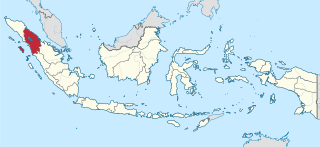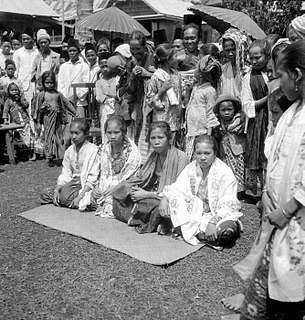
North Sumatra is a province of Indonesia located on the northern part of the island of Sumatra. Its capital and largest city is Medan. North Sumatra is the fourth most-populous province after West Java, East Java and Central Java. The province covers an area of 72,981 km2. According to the 2020 population census, the province had a population of 14,799,361.

Toba Batak is an Austronesian language spoken in North Sumatra province in Indonesia. It is part of a group of languages called "Batak".

Karo, referred to in Indonesia as Bahasa Karo, is an Austronesian language that is spoken by the Karo people of Indonesia. It is used by around 600,000 people in North Sumatra. It is mainly spoken in Karo Regency, southern parts of Deli Serdang Regency and northern parts of Dairi Regency, North Sumatra, Indonesia. It was historically written using the Batak alphabet which is descended from the Brahmi script of ancient India by way of the Pallava and Old Kawi scripts, but nowadays only a tiny number of Karo can write or understand the script, and instead the Latin script is used.

Pakpak Bharat Regency is a regency in North Sumatra, Indonesia. The regency covers an area of 1,218.3 square kilometres and it had a population of 40,481 at the 2010 census and 52,351 at the 2020 Census. Its seat is the town of Salak.
Lawangan is an Austronesian language of the East Barito group. It is spoken by about 100,000 Lawangan people living in the central Kalimantan, Indonesia. Lawangan has a high degree of dialectal diversity.
Palembang, also known as Palembang Malay, or Musi, is a Malayic language primarily spoken in about two thirds of South Sumatra Province in Indonesia, especially along the Musi River. It consists of two separate but mutually intelligible dialect chains: Musi and Palembang. The urban Palembang dialect is a koiné that emerged in Palembang, the capital city of South Sumatra. It has become a lingua franca throughout major population centers in the province, and is often used polyglossically with Indonesian and other regional languages and dialects in the area. Since parts of South Sumatra used to be under direct Javanese rule for quite a long time, the speech varieties of Palembang and its surrounding area are significantly influenced by Javanese, down to their core vocabularies.

The Simalungun people are an ethnic group in North Sumatra, considered one of the Batak peoples. Simalungun people live mostly in Simalungun Regency and the surrounding areas, including the city of Pematang Siantar, an autonomous city, but previously part of Simalungun Regency.

Toba people are the most numerous of the Batak people of North Sumatra, Indonesia, and often considered the classical 'Batak', most likely to willingly self-identify as Batak. The Toba people are found in Toba Samosir Regency, Humbang Hasundutan Regency, Samosir Regency, North Tapanuli Regency, part of Dairi Regency, Central Tapanuli Regency, Sibolga and its surrounding regions. The Batak Toba people speak in the Toba Batak language and are centered on Lake Toba and Samosir Island within the lake. Batak Toba people frequently build in traditional Batak architecture styles which are common on Samosir. Cultural demonstrations, performances and festivities such as Sigale Gale are often held for tourists.
Kendayan, or Salako (Selako), is a Malayic Dayak language of Borneo. The exact number of speakers remains unknown, but is estimated to be around 350,000.
Kerinci is a Malayan language spoken in Jambi Province, Sumatra especially in Kerinci Regency and Sungai Penuh city. It has a high dialectical diversity, with dialects Ulu, Mamaq, Akit, Talang and Sakei.

Angkola people are one of the sub-ethnic groups comprising the Batak people from North Sumatra who live in South Tapanuli regency. The Angkola language is similar to Mandailing language, but it is sociolinguistically distinct.
Pakpak or Pakpak Dairi people are one of the ethnic group of Batak people found mainly in North Sumatra, Indonesia. They are scattered in a few regencies and cities in North Sumatra and Aceh, such as Dairi Regency, Pakpak Bharat Regency, Humbang Hasundutan Regency and Central Tapanuli Regency of North Sumatra, and also in Aceh Singkil Regency and Subulussalam, Aceh.

Singkil people are an ethnic group of people found in Aceh Singkil Regency and Subulussalam, Aceh province, Indonesia.

Rejang people are an Austronesian ethnolinguistic group, native to the some parts of Bengkulu Province and South Sumatera Province in the southwestern part of Sumatera Island, Indonesia. They occupied some area in a cool mountain slopes of the Barisan mountain range in both sides of Bengkulu and South Sumatra. With approximately more than 1,3 million people, they form the largest ethnic group in Bengkulu Province. Rejang people predominantly live as a majority in 5 out 10 regencies and city of Bengkulu Province, while the rest of them who lives in South Sumatera resides at 7 villages in the district called as Bermani Ulu Rawas. The Rejangs are predominantly an Islam adherent group with small numbers following a religion other than Islam. According to research, Rejang people are the descendants of the Bukar-Sadong people who migrated from Northern Borneo (Sarawak).
Mante people or also spelled as Mantir, are one of the earliest ethnic group frequently mentioned in legendary folklore to have inhabited Aceh, Indonesia. This ethnic group along with other indigenous people such as the Illanun people, Sakai people, Jakun people, Senoi and Semang, are the ethnic groups that formed the existing Acehnese people today. The Mante people are regarded as part of the Proto-Malay people group that initially settled around the region of Aceh Besar Regency and in the interior jungle. These indigenous people were thought to have migrated to Aceh through the Malay peninsula. In the Acehnese legend, the Batak and Mante people were mentioned as the descendants of Kawom Lhèë Reutōïh ; which were also one of the indigenous peoples in Aceh, Indonesia. Today, this people are extinct or have disappeared as a result of intermarriage with other non-indigenous people groups that arrived later. To date, there are still no strong scientific evidence for the existence of this people.

Bungku people are an ethnic group who mostly resides in North Bungku, South Bungku, Central Bungku, and Menui Islands districts di Morowali Regency, in Central Sulawesi province of Indonesia. This ethnic group is divided into several sub-groups, namely Lambatu, Epe, Ro'tua, Reta, and Wowoni. Bungku people have their own language, called Bungku language, which is one of their characteristic and serves as a means of communication between themselves. They generally embrace Islam or Christianity.

Sitopayan I inscription is an inscription written in a mixed of Old Malay and Old Batak languages, written mostly using Old Javanese characters with some words using Old Batak characters. The inscription was found at the Biaro (temple) Si Topayan, in Sitopayan village, Portibi District, North Padang Lawas Regency, North Sumatra Province, Indonesia. The inscription is quite short, it is written on one of the horizontal sides of a base of a stone idol. F.D.K. Bosch thought that this inscription was made in the 13th century CE, based on the shape and characteristics of the script.
Sitopayan II inscription is an inscription written in Proto Batak language and using Old Batak characters. The inscription was found at the Biaro (temple) Si Topayan, in Sitopayan village, Portibi District, North Padang Lawas Regency, North Sumatra Province, Indonesia. The inscription consists of two short lines, written on a horizontal side of the base of a stone idol. F.D.K. Bosch thought that this inscription was made in the 13th century CE, based on the shape and characteristics of the script.

Old Sundanese is the earliest recorded stage of the Sundanese language which is spoken in the western part of Java. The evidence is recorded in inscriptions from around the 11th to 14th centuries and ancient lontar manuscripts from the 15th to 17th centuries AD. Old Sundanese is no longer used today, but has developed into its descendant, modern Sundanese.
Cirebonese Sundanese is a variety of conversation in Sundanese in the ex-Residency of Cirebon and its surroundings, which includes Kuningan, Majalengka, Cirebon, Indramayu and Subang as well as Brebes in Central Java.











